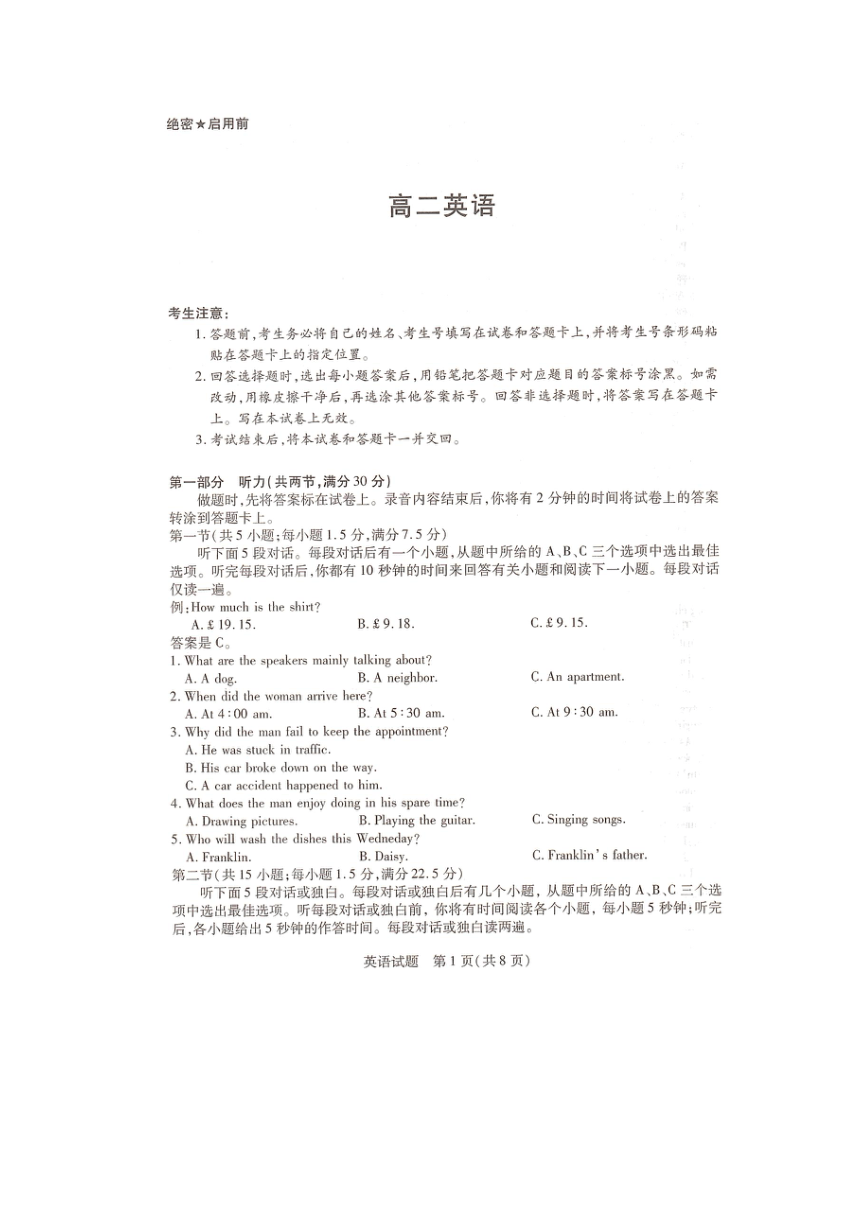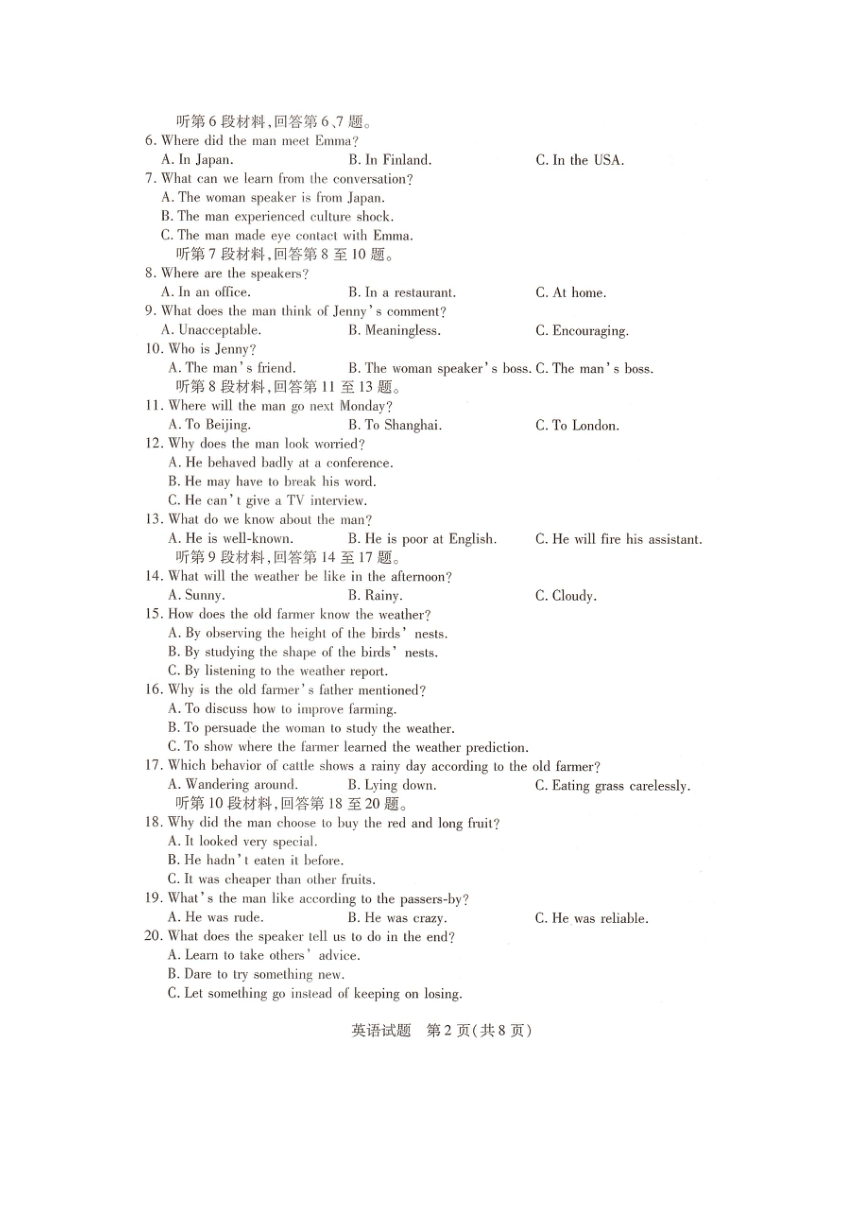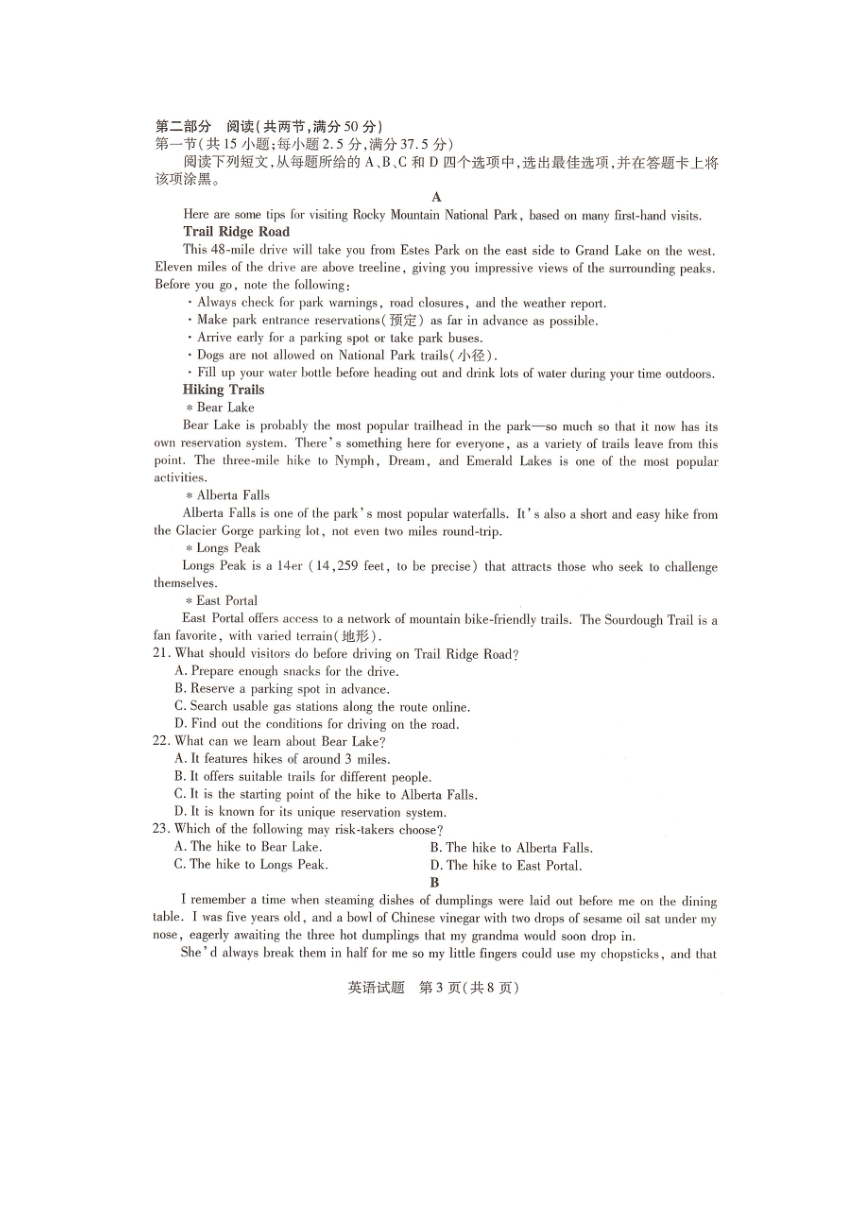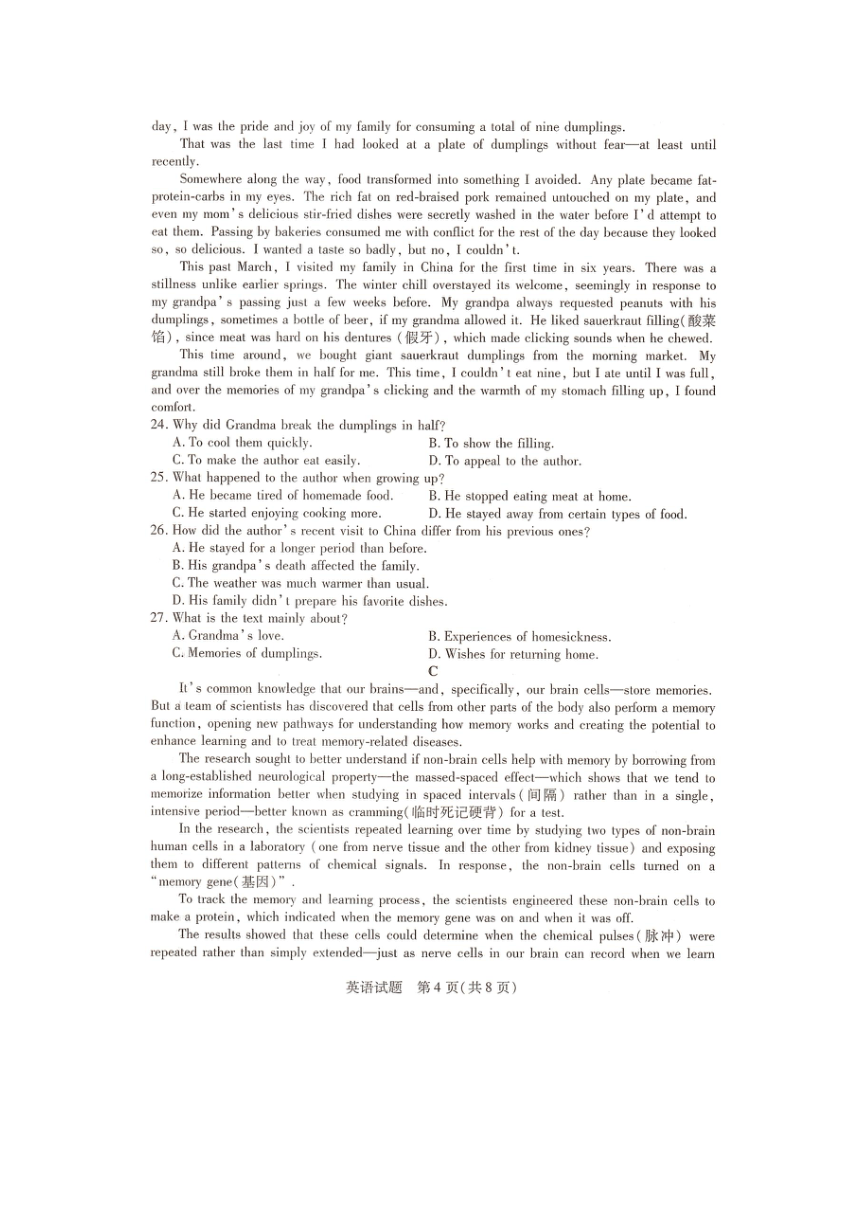湖南省衡阳市衡阳县2024-2025学年高二上学期1月期末英语试题(扫描版无答案)
文档属性
| 名称 | 湖南省衡阳市衡阳县2024-2025学年高二上学期1月期末英语试题(扫描版无答案) |

|
|
| 格式 | docx | ||
| 文件大小 | 11.5MB | ||
| 资源类型 | 教案 | ||
| 版本资源 | 人教版(2019) | ||
| 科目 | 英语 | ||
| 更新时间 | 2025-01-11 12:00:32 | ||
图片预览




文档简介
day,I was the pride and joy of my family for consuming a total of nine dumplings
That was the last time I had looked at a plate of dumplings without fear-at least until
recently.
Somewhere along the way,food transformed into something I avoided.Any plate became fat-
protein-carbs in my eyes.The rich fat on red-braised pork remained untouched on my plate,and
even my mom's delicious stir-fried dishes were secretly washed in the water before I'd attempt to
eat them.Passing by bakeries consumed me with conflict for the rest of the day because they looked
so,so delicious.I wanted a taste so badly,but no,I couldn't.
This past March,I visited my family in China for the first time in six years.There was a
stillness unlike earlier springs.The winter chill overstayed its welcome,seemingly in response to
my grandpa's passing just a few weeks before.My grandpa always requested peanuts with his
dumplings,sometimes a bottle of beer,if my grandma allowed it.He liked sauerkraut filling(
馅),since meat was hard on his dentures(假牙),which made clicking sounds when he chewed..
This time around,we bought giant sauerkraut dumplings from the morning market.My
grandma still broke them in half for me.This time,I couldn't eat nine,but I ate until I was full,
and over the memories of my grandpa's clicking and the warmth of my stomach filling up,I found
comfort.
24.Why did Grandma break the dumplings in half
A.To cool them quickly.
B.To show the filling.
C.To make the author eat easily.
D.To appeal to the author.
25.What happened to the author when growing up
A.He became tired of homemade food.
B.He stopped eating meat at home.
C.He started enjoying cooking more.
D.He stayed away from certain types of food.
26.How did the author's recent visit to China differ from his previous ones
A.He stayed for a longer period than before.
B.His grandpa's death affected the family.
C.The weather was much warmer than usual.
D.His family didn't prepare his favorite dishes.
27.What is the text mainly about
A.Grandma's love.
B.Experiences of homesickness.
C.Memories of dumplings.
D.Wishes for returning home.
C
It's common knowledge that our brains-and,specifically,our brain cells-store memories.
But a team of scientists has discovered that cells from other parts of the body also perform a memory
function,opening new pathways for understanding how memory works and creating the potential to
enhance learning and to treat memory-related diseases.
The research sought to better understand if non-brain cells help with memory by borrowing from
a long-established neurological property-the massed-spaced effect-which shows that we tend to
memorize information better when studying in spaced intervals (rather than in a single,
intensive period-一better known as cramming(临时死记硬背)for a test.
In the research,the scientists repeated learning over time by studying two types of non-brain
human cells in a laboratory (one from nerve tissue and the other from kidney tissue)and exposing
them to different patterns of chemical signals.In response,the non-brain cells turned on a
“memory gene(基因)”.
To track the memory and learning process,the scientists engineered these non-brain cells to
make a protein,which indicated when the memory gene was on and when it was off.
The results showed that these cells could determine when the chemical pulses()were
repeated rather than simply extended-just as nerve cells in our brain can record when we learn
英语试题第4页(共8页)
That was the last time I had looked at a plate of dumplings without fear-at least until
recently.
Somewhere along the way,food transformed into something I avoided.Any plate became fat-
protein-carbs in my eyes.The rich fat on red-braised pork remained untouched on my plate,and
even my mom's delicious stir-fried dishes were secretly washed in the water before I'd attempt to
eat them.Passing by bakeries consumed me with conflict for the rest of the day because they looked
so,so delicious.I wanted a taste so badly,but no,I couldn't.
This past March,I visited my family in China for the first time in six years.There was a
stillness unlike earlier springs.The winter chill overstayed its welcome,seemingly in response to
my grandpa's passing just a few weeks before.My grandpa always requested peanuts with his
dumplings,sometimes a bottle of beer,if my grandma allowed it.He liked sauerkraut filling(
馅),since meat was hard on his dentures(假牙),which made clicking sounds when he chewed..
This time around,we bought giant sauerkraut dumplings from the morning market.My
grandma still broke them in half for me.This time,I couldn't eat nine,but I ate until I was full,
and over the memories of my grandpa's clicking and the warmth of my stomach filling up,I found
comfort.
24.Why did Grandma break the dumplings in half
A.To cool them quickly.
B.To show the filling.
C.To make the author eat easily.
D.To appeal to the author.
25.What happened to the author when growing up
A.He became tired of homemade food.
B.He stopped eating meat at home.
C.He started enjoying cooking more.
D.He stayed away from certain types of food.
26.How did the author's recent visit to China differ from his previous ones
A.He stayed for a longer period than before.
B.His grandpa's death affected the family.
C.The weather was much warmer than usual.
D.His family didn't prepare his favorite dishes.
27.What is the text mainly about
A.Grandma's love.
B.Experiences of homesickness.
C.Memories of dumplings.
D.Wishes for returning home.
C
It's common knowledge that our brains-and,specifically,our brain cells-store memories.
But a team of scientists has discovered that cells from other parts of the body also perform a memory
function,opening new pathways for understanding how memory works and creating the potential to
enhance learning and to treat memory-related diseases.
The research sought to better understand if non-brain cells help with memory by borrowing from
a long-established neurological property-the massed-spaced effect-which shows that we tend to
memorize information better when studying in spaced intervals (rather than in a single,
intensive period-一better known as cramming(临时死记硬背)for a test.
In the research,the scientists repeated learning over time by studying two types of non-brain
human cells in a laboratory (one from nerve tissue and the other from kidney tissue)and exposing
them to different patterns of chemical signals.In response,the non-brain cells turned on a
“memory gene(基因)”.
To track the memory and learning process,the scientists engineered these non-brain cells to
make a protein,which indicated when the memory gene was on and when it was off.
The results showed that these cells could determine when the chemical pulses()were
repeated rather than simply extended-just as nerve cells in our brain can record when we learn
英语试题第4页(共8页)
同课章节目录
